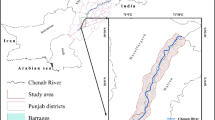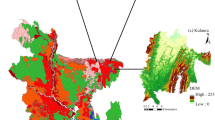Abstract
Accurate assessment of surface water from satellite and remote sensing data plays an important role in water and flood management and supporting natural ecosystems and human development. Remote sensing imagery has significantly advanced in water extraction methods, particularly in water index, classification, and sub-pixel analysis. Water-index-based approaches offer notable advantages such as speed and convenience among these methods. The unique characteristics of surface water and flooded areas, including their extensive coverage and dynamic nature, make the water index particularly effective for monitoring large regions. However, the complexity of land surfaces in aquatic environments presents challenges that hinder accurate water extraction. These challenges differ across various factors, such as shadows in urban and mountainous areas, small water bodies, muddy water, and water leakage in unshaded regions. The current study introduces a novel Flood/Water Extraction Index (FWEI) for identifying water and flooded areas to address these challenges. The FWEI utilizes the average ratio of visible and near-infrared bands derived from Sentinel-2 images. The proposed index utilizes images with 10-m and average visible bands and more effectively compensates for errors arising from spectral and spatial changes. Therefore, it demonstrates strong performance by more accurately mapping muddy and clear water within small water bodies and narrow rivers. The performance of the offered FWEI index is compared with other indices, including the Normalized Difference Water Indices (NDWI-G, NDWI-F), Modified NDWI (MNDWI-1, MNDWI-2), and the Automatic Water Extraction Index (AWEInsh) without shadow. While other indices excel in specific scenarios, such as built-up or non-built-up areas, and bare lands versus vegetated areas, the FWEI index demonstrates consistently high accuracy and stability in extracting surface water across diverse backgrounds. The FWEI index achieves an average Overall Accuracy (OA) of 94.26% for water extraction and 93.11% for flood extraction. In comparison, the AWEInsh attains an OA of 90.48% and 90.39%, NDWI-F performs at 86.69% and 86.55%, MNDWI-1 at 77.21% and 75.82%, MNDWI-2 at 76.12% and 75.42%, and NDWI-G at 75.26% and 74.78%, respectively. The integration of visible spectral bands with the near-infrared band proves instrumental in enhancing the accuracy of water derivation in complex and expansive environments.
















Similar content being viewed by others
Data availability
Upon request, the corresponding author is willing to share the datasets analyzed in this research.
References
Acharya TD, Subedi A, Lee DH (2018) Evaluation of water indices for surface water extraction in a Landsat 8 scene of Nepal. Sensors 18(8):2580
Amani M, Ghorbanian A, Ahmadi SA, Kakooei M, Moghimi A, Mirmazloumi SM, Moghaddam SHA, Mahdavi S, Ghahremanloo M, Parsian S, Wu Q (2020) Google earth engine cloud computing platform for remote sensing big data applications: a comprehensive review. IEEE J Sel Top Appl Earth Obs Remote Sens 13:5326–5350
Bijeesh T, Narasimhamurthy K (2020) Surface water detection and delineation using remote sensing images: A review of methods and algorithms. Sustain Water Res Manag 6:1–23
Chen J, Chen J, Liao A, Cao X, Chen L, Chen X, He C, Han G, Peng S, Lu M (2015) Global land cover mapping at 30 m resolution: A POK-based operational approach. ISPRS J Photogramm Remote Sens 103:7–27
Chowdhury EH, Hassan QK (2017) Use of remote sensing data in comprehending an extremely unusual flooding event over southwest Bangladesh. Nat Hazards 88:1805–1823
Cui T, Zhang J, Wang K, Wei J, Mu B, Ma Y, Zhu J, Liu R, Chen X (2020) Remote sensing of chlorophyll a concentration in turbid coastal waters based on a global optical water classification system. ISPRS J Photogramm Remote Sens 163:187–201
DeVries B, Huang C, Armston J, Huang W, Jones JW, Lang MW (2020) Rapid and robust monitoring of flood events using Sentinel-1 and Landsat data on the google earth engine. Remote Sens Environ 240:111664
Dong Z, Wang G, Amankwah SOY, Wei X, Hu Y, Feng A (2021) Monitoring the summer flooding in the Poyang Lake area of China in 2020 based on Sentinel-1 data and multiple convolutional neural networks. Int J Appl Earth Obs Geoinf 102:102400
Du Y, Zhang Y, Ling F, Wang Q, Li W, Li X (2016) Water bodies’ mapping from Sentinel-2 imagery with modified normalized difference water index at 10-m spatial resolution produced by sharpening the SWIR band. Remote Sens 8(4):354
Farhadi H, Esmaeily A, Najafzadeh M (2022a) Flood monitoring by integration of remote sensing technique and multi-criteria decision making method. Comput Geosci 160:105045
Farhadi H, Managhebi T, Ebadi H (2022b) Buildings extraction in urban areas based on the radar and optical time series data using google earth engine. Sci-Res Q Geogr Data (SEPEHR) 30(120):43–63
Farhadi H, Mokhtarzade M, Ebadi H, Beirami BA (2022c) Rapid and automatic burned area detection using sentinel-2 time-series images in google earth engine cloud platform: a case study over the Andika and Behbahan Regions. Iran Environ Monit Assess 194(5):369
Farhadi H, Ebadi H, Kiani A (2023a) Badi: a novel burned area detection index for SENTINEL-2 imagery using google earth engine platform. ISPRS Ann Photogramm Remote Sens Spat Inf Sci 10:179–186
Farhadi H, Ebadi H, Kiani A (2023b) F2BFE: development of feature-based building footprint extraction by remote sensing data and GEE. Int J Remote Sens 44(19):5845–5875
Feyisa GL, Meilby H, Fensholt R, Proud SR (2014) Automated water extraction index: a new technique for surface water mapping using landsat imagery. Remote Sens Environ 140:23–35
Filipponi F (2018). BAIS2: Burned area index for Sentinel-2. Paper presented at the Proceedings.
Gao B-C (1996) NDWI—A normalized difference water index for remote sensing of vegetation liquid water from space. Remote Sens Environ 58(3):257–266
Goffi A, Stroppiana D, Brivio PA, Bordogna G, Boschetti M (2020) Towards an automated approach to map flooded areas from Sentinel-2 MSI data and soft integration of water spectral features. Int J Appl Earth Obs Geoinf 84:101951
Gstaiger V, Huth J, Gebhardt S, Wehrmann T, Kuenzer C (2012) Multi-sensoral and automated derivation of inundated areas using TerraSAR-X and ENVISAT ASAR data. Int J Remote Sens 33(22):7291–7304
Inman VL, Lyons MB (2020) Automated inundation mapping over large areas using Landsat data and google earth engine. Remote Sens 12(8):1348
Jiang W, Ji X, Li Y, Luo X, Yang L, Ming W, Liu C, Yan S, Yang C, Sun C (2023) Modified flood potential index (MFPI) for flood monitoring in terrestrial water storage depletion basin using GRACE estimates. J Hydrol 616:128765
Khan R, Gilani H (2021) Global drought monitoring with drought severity index (DSI) using google earth engine. Theoret Appl Climatol 146(1–2):411–427
Kimijima S, Nagai M (2023) High Spatiotemporal flood monitoring associated with rapid lake shrinkage using planet smallsat and Sentinel-1 data. Remote Sens 15(4):1099
Luo X., Xie H., Xu X., Pan H., & Tong X. (2016). A hierarchical processing method for subpixel surface water mapping from highly heterogeneous urban environments using Landsat OLI data. Paper presented at the 2016 IEEE International Geoscience and Remote Sensing Symposium (IGARSS).
McFeeters SK (1996) The use of the Normalized Difference Water Index (NDWI) in the delineation of open water features. Int J Remote Sens 17(7):1425–1432
Moharrami M, Javanbakht M, Attarchi S (2021) Automatic flood detection using sentinel-1 images on the google earth engine. Environ Monit Assess 193:1–17
Mohite, J., Twarakavi, N., & Pappula, S. (2018). Evaluating the potential of sentinel-2 for low severity mites infestation detection in grapes. Paper presented at the IGARSS 2018–2018 IEEE International Geoscience and Remote Sensing Symposium.
Najafzadeh M, Homaei F, Farhadi H (2021) Reliability assessment of water quality index based on guidelines of national sanitation foundation in natural streams: Integration of remote sensing and data-driven models. Artif Intell Rev 54(6):4619–4651
Otsu N (1979) A threshold selection method from gray-level histograms. IEEE Trans Syst Man Cybern 9(1):62–66
Pickens AH, Hansen MC, Hancher M, Stehman SV, Tyukavina A, Potapov P, Marroquin B, Sherani Z (2020) Mapping and sampling to characterize global inland water dynamics from 1999 to 2018 with full Landsat time-series. Remote Sens Environ 243:111792
Rahman MS, Di L, Yu E, Lin L, Zhang C, Tang J (2019) Rapid flood progress monitoring in cropland with NASA SMAP. Remote Sens 11(2):191
Rokni K, Ahmad A, Selamat A, Hazini S (2014) Water feature extraction and change detection using multitemporal Landsat imagery. Remote Sens 6(5):4173–4189
Sekertekin A (2019) Potential of global thresholding methods for the identification of surface water resources using Sentinel-2 satellite imagery and normalized difference water index. J Appl Remote Sens 13(4):044507–044507
Shen X, Wang D, Mao K, Anagnostou E, Hong Y (2019) Inundation extent mapping by synthetic aperture radar: a review. Remote Sens 11(7):879
Sun F, Sun W, Chen J, Gong P (2012) Comparison and improvement of methods for identifying waterbodies in remotely sensed imagery. Int J Remote Sens 33(21):6854–6875
Tong X, Luo X, Liu S, Xie H, Chao W, Liu S, Liu S, Makhinov A, Makhinova A, Jiang Y (2018) An approach for flood monitoring by the combined use of Landsat 8 optical imagery and COSMO-SkyMed radar imagery. ISPRS J Photogramm Remote Sens 136:144–153
Tran KH, Menenti M, Jia L (2022) Surface water mapping and flood monitoring in the mekong delta using Sentinel-1 SAR time series and Otsu threshold. Remote Sens 14(22):5721
Wang X, Xie S, Zhang X, Chen C, Guo H, Du J, Duan Z (2018) A robust multi-band water index (MBWI) for automated extraction of surface water from Landsat 8 OLI imagery. Int J Appl Earth Obs Geoinf 68:73–91
Wang J, Wang F, Wang S, Zhou Y, Ji J, Wang Z, Zhao Q, Liu L (2023) Flood monitoring in the middle and lower basin of the Yangtze river using google earth engine and machine learning methods. ISPRS Int J Geo Inf 12(3):129
Wolski P, Murray-Hudson M, Thito K, Cassidy L (2017) Keeping it simple: monitoring flood extent in large data-poor wetlands using MODIS SWIR data. Int J Appl Earth Obs Geoinf 57:224–234
Xie H, Luo X, Xu X, Pan H, Tong X (2016) Automated subpixel surface water mapping from heterogeneous urban environments using Landsat 8 OLI imagery. Remote Sens 8(7):584
Xiong L, Deng R, Li J, Liu X, Qin Y, Liang Y, Liu Y (2018) Subpixel surface water extraction (SSWE) using Landsat 8 OLI data. Water 10(5):653
Xu H (2006) Modification of normalised difference water index (NDWI) to enhance open water features in remotely sensed imagery. Int J Remote Sens 27(14):3025–3033
Yamazaki D, Trigg MA, Ikeshima D (2015) Development of a global~ 90 m water body map using multi-temporal Landsat images. Remote Sens Environ 171:337–351
Zoka, M., Psomiadis, E., & Dercas, N. (2018). The complementary use of optical and SAR data in monitoring flood events and their effects. Paper presented at the Proceedings.
Funding
This study did not receive public or commercial funding agencies' grants, funds, or other support.
Author information
Authors and Affiliations
Contributions
HF: Introduction, material and method, Programming, visualization, data processing, result and discussion, validation, original draft, analysis, and review & editing. HE, AK and AA: Analysis, review & editing, supervision.
Corresponding author
Ethics declarations
Competing interests
The authors declare no competing interests.
Conflict of interest
No conflicts of interest or personal relationships are known to the authors that may have affected the work described in this article.
Additional information
Publisher's Note
Springer Nature remains neutral with regard to jurisdictional claims in published maps and institutional affiliations.
Rights and permissions
Springer Nature or its licensor (e.g. a society or other partner) holds exclusive rights to this article under a publishing agreement with the author(s) or other rightsholder(s); author self-archiving of the accepted manuscript version of this article is solely governed by the terms of such publishing agreement and applicable law.
About this article
Cite this article
Farhadi, H., Ebadi, H., Kiani, A. et al. A novel flood/water extraction index (FWEI) for identifying water and flooded areas using sentinel-2 visible and near-infrared spectral bands. Stoch Environ Res Risk Assess 38, 1873–1895 (2024). https://doi.org/10.1007/s00477-024-02660-z
Accepted:
Published:
Issue Date:
DOI: https://doi.org/10.1007/s00477-024-02660-z




